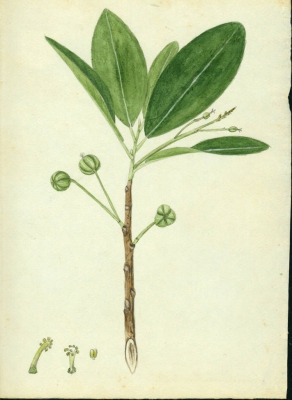Sapium laurocerasus
Desf.
Euphorbiaceae
Excoecaria laurocerasus (Desf.) Müll.Arg.
Stillingia laurocerasus (Desf.) Baill.
Common Name:
General Information
Sapium laurocerasus is an evergreen tree with a columnar crown; it can grow from 6 - 18 metres tall. The bole can be up to 60cm in diameter[
447- Title
- Common Trees of Puerto Rico and the Virgin Islands
- Publication
-
- Author
- Little E.L.; Wadsworth F.H.
- Publisher
- USDA, Forest Service; Washington.
- Year
- 1964
- ISBN
-
- Description
- Contains detailed information, and usually an illustration, on 250 tree species, including both native and exotic species.
].
The tree is sometimes harvested from the wild for local use of its wood[
447- Title
- Common Trees of Puerto Rico and the Virgin Islands
- Publication
-
- Author
- Little E.L.; Wadsworth F.H.
- Publisher
- USDA, Forest Service; Washington.
- Year
- 1964
- ISBN
-
- Description
- Contains detailed information, and usually an illustration, on 250 tree species, including both native and exotic species.
].
Known Hazards
The plant contains an abundance of an irritating, poisonous latex[
447- Title
- Common Trees of Puerto Rico and the Virgin Islands
- Publication
-
- Author
- Little E.L.; Wadsworth F.H.
- Publisher
- USDA, Forest Service; Washington.
- Year
- 1964
- ISBN
-
- Description
- Contains detailed information, and usually an illustration, on 250 tree species, including both native and exotic species.
].
Botanical References
Range
Caribbean - Puerto Rico.
Habitat
Forests of the lower to upper mountains, and in moist limestone regions[
447- Title
- Common Trees of Puerto Rico and the Virgin Islands
- Publication
-
- Author
- Little E.L.; Wadsworth F.H.
- Publisher
- USDA, Forest Service; Washington.
- Year
- 1964
- ISBN
-
- Description
- Contains detailed information, and usually an illustration, on 250 tree species, including both native and exotic species.
].
Properties
| Other Uses Rating |      |
| Habit | Evergreen Tree |
| Height | 12.00 m |
| Cultivation Status | Wild |
Cultivation Details
Not known
Edible Uses
None known
Medicinal
None known
Other Uses
The heartwood is light brown or light yellow; the sapwood whitish. It is mostly fine-textured, except for many large pores which are visible to the naked eye on the end grain and appear as fine scratches or stipple marks on flatsawn surfaces; the grain is sometimes straight, more frequently tightly interlocked; lustre is medium; there are no visible growth rings; the seasoned wood is free of odour or taste. The wood is soft; light in weight; not very durable, being very susceptible to attack by dry-wood termites and other insects and to decay. Sap-staining fungi discolour freshly cut wood if it is neither dipped in fungicide nor dried promptly. Rate of air-seasoning and amount of degrade are moderate. Machining characteristics are as follows: planing is excellent; shaping and turning are fair; boring and mortising are poor; sanding is very poor unless only very fine abrasive paper is used; and resistance to screw splitting is good. Though cut occasionally for posts, the wood is unpopular because the caustic latex injures the skin. It is suitable for boxes, crates, interior construction, paper pulp, and plywood[
447- Title
- Common Trees of Puerto Rico and the Virgin Islands
- Publication
-
- Author
- Little E.L.; Wadsworth F.H.
- Publisher
- USDA, Forest Service; Washington.
- Year
- 1964
- ISBN
-
- Description
- Contains detailed information, and usually an illustration, on 250 tree species, including both native and exotic species.
,
471- Title
- Puerto Rican Woods. Agriculture Handbook No. 205
- Publication
-
- Author
- Longwood F.R.
- Publisher
- USDA Forest Service; Washington
- Year
- 1961
- ISBN
-
- Description
- Descriptions of 60 timbers from Puerto Rica.
].
Propagation
Seed -
If you have any useful information about this plant, please leave a comment. Comments have to be approved before they are shown here.






 Useful Tropical Plants Database 2014 by
Ken Fern,
web interface by
Ajna Fern
with help from
Richard Morris.
Useful Tropical Plants Database 2014 by
Ken Fern,
web interface by
Ajna Fern
with help from
Richard Morris.